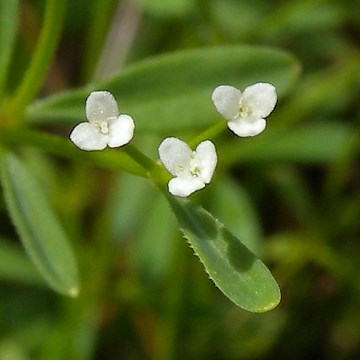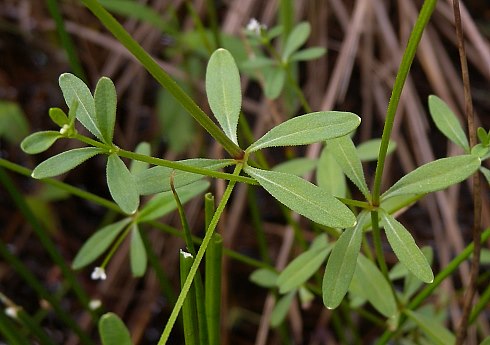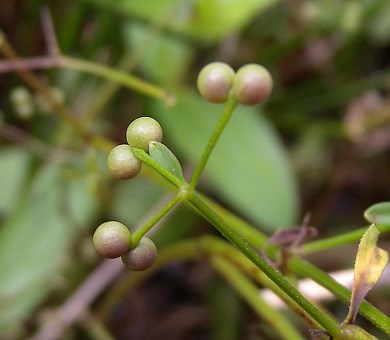
Both terminal and axillary cymes of 1-3 flowers are produced. Individual flowers are 1/8" (3 mm.) across or a little less; each flower has a white corolla with 3 (less often 4) spreading lobes, a bifurcated two-celled ovary with a pair of styles, and 3 (less often 4) stamens. The surface of the ovary is green and smooth. The pedicels of the flowers or fruits are up to 1" long, straight, and angular; their edges are smooth. The blooming period occurs during the summer for about 2-3 months. Usually, only a few flowers are in bloom at the same time. Each flower is replaced by a two-celled seedpod that is about 1/8" (3 mm.) across. The seedpod changes color as it matures from green, to purple, and black. Each cell of the pod is globoid-ovoid in shape, smooth, and single-seeded. The root system is fibrous and rhizomatous.
Cultivation: The preference is full or partial sun, wet to moist conditions, and soil containing loam, clay-loam, sand, or gravel. Standing water is readily tolerated if it is temporary.

Range & Habitat: The native Stiff Bedstraw is occasional in northern Illinois, and uncommon or absent in the rest of the state (see Distribution Map). Habitats include marshes, fens, low areas along rivers and ponds, swamps, wet sand prairies, prairie swales, and ditches. Stiff Bedstraw is usually found in higher quality wetlands in Illinois.
Faunal Associations: The flowers are cross-pollinated by flies and small bees. The caterpillars of some moths feed on the foliage or flower tissues of Galium spp. These species include: Epirrhoe alternata (White-Bordered Toothed Carpet), Hyles gallii (Galium Sphinx), Lobocleta ossularia (Drab Brown Wave), and Scopula inductata (Soft-Lined Wave). The species Myzus cerasi (Black Cherry Aphid) uses Galium spp. as summer hosts. Three plant bugs in Illinois are known to feed on these plants: Criocoris saliens, Polymerus proximus, and the introduced Polymerus unifasciatus. White-Tailed Deer browse on the foliage sparingly or not at all. Because the bristly hairs of the stems and leaves can cling to passing objects, animals may play a minor role in spreading the seeds to new locations.

Photographic Location: A wet sand prairie at the Indiana Dunes National Lakeshore in NW Indiana.
Comments: Stiff Bedstraw is unusual because its corollas can have 3-4 lobes on the same plant. In Illinois, the only other bedstraw with 3 lobes on its corollas is Small Bedstraw (Galium trifidum). This latter species is similar to Stiff Bedstraw, but smaller in size and slightly more bristly. In particular, the pedicels of Small Bedstraw are bristly and curved, while those of Stiff Bedstraw are smooth and straight. While Stiff Bedstraw is scattered throughout Illinois, Small Bedstraw is restricted to northern Illinois and a sandy area of central Illinois. This latter species has a more northern distribution and prefers a cool climate.